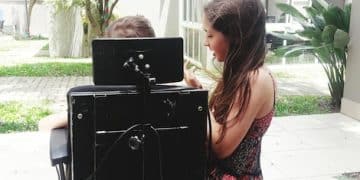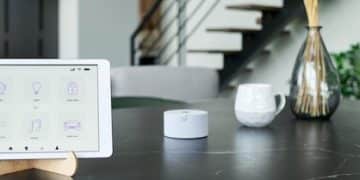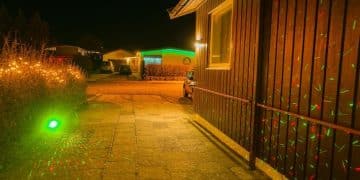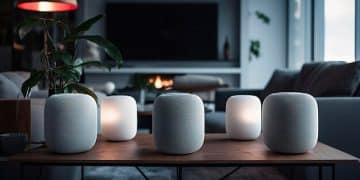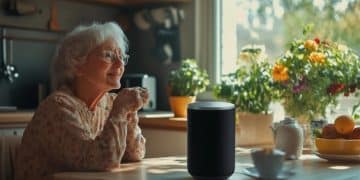Elder Safety: Top 5 Smart Home Devices to Prevent Falls
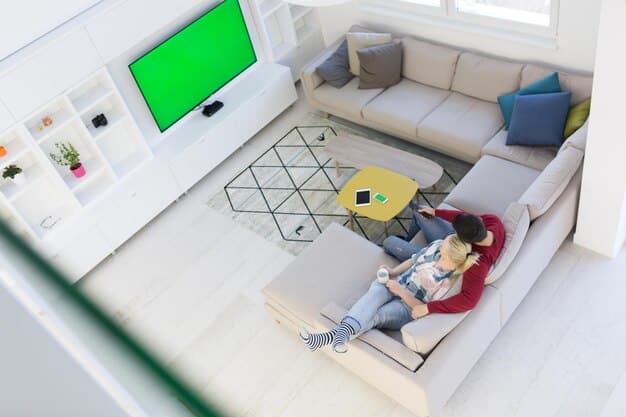
Elder Safety: Top 5 Smart Home Devices to Prevent Falls and Accidents focuses on innovative technologies like smart speakers, wearable health trackers, and sensor-based monitoring systems that enhance the safety and well-being of elderly individuals in their homes.
Creating a safe and secure home environment is crucial for maintaining the independence and well-being of elderly individuals. With advancements in technology, smart home devices offer innovative solutions to prevent falls and accidents. Let’s explore the Elder Safety: Top 5 Smart Home Devices to Prevent Falls and Accidents, designed to enhance safety and promote peace of mind.
Enhancing Elder Safety with Smart Home Technology
Falls are a leading cause of injury among older adults, often resulting in hospitalization and reduced quality of life. Smart home technology can significantly mitigate these risks by providing real-time monitoring, immediate assistance, and a safer living environment. This is where the role of smart home devices in assisting and monitoring the day-to-day lives of elderly individuals can be critical.
The integration of these devices not only offers a sense of security but also empowers seniors to maintain their independence and active lifestyles. Let’s delve into the specifics of how these devices operate and the benefits they bring.
Why Choose Smart Home Devices for Elder Safety?
Smart home devices offer a range of features tailored to the unique needs of elderly individuals. From fall detection to medication reminders, these devices are designed to provide comprehensive safety and support.
Traditional methods of elder care often rely on constant supervision, which can be intrusive and costly. Smart home solutions offer a more discreet and cost-effective way to ensure the safety and well-being of seniors.
- Real-time monitoring and alerts
- Improved response times in emergencies
- Enhanced independence and reduced feelings of isolation
- Cost-effective compared to traditional care options
Smart home devices provide a proactive approach to elder safety, addressing potential hazards before they become serious incidents. This can lead to a significant improvement in the overall quality of life for seniors and their families.
In conclusion, incorporating smart home technologies into the living spaces of elderly individuals is a practical and effective way to promote safety and independence. It offers a comprehensive solution that addresses various aspects of elder care, from fall prevention to medication management.
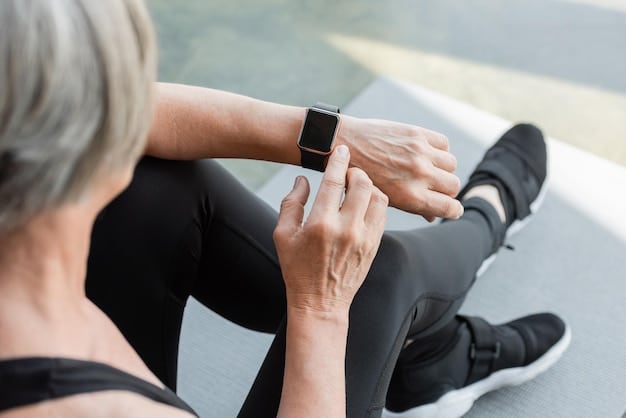
Smart Speakers: Voice-Activated Assistance
Smart speakers like Amazon Echo and Google Home offer voice-activated assistance, making it easier for seniors to control their environment and access help in emergencies. These devices can be used to make calls, set reminders, and control other smart home devices.
The simplicity of voice commands eliminates the need for complex interfaces, enabling seniors to interact with technology effortlessly. This makes smart speakers an invaluable tool for promoting independence and safety.
How Smart Speakers Enhance Elder Safety
Smart speakers can be programmed to recognize specific voice commands, allowing seniors to call for help, contact family members, or access emergency services with ease.
These devices can also be used to automate daily tasks, such as turning on lights, adjusting the thermostat, and playing music or audiobooks, thus enhancing comfort and convenience.
- Hands-free communication
- Automated task management
- Emergency assistance and alerts
- Entertainment and cognitive stimulation
Smart speakers can also be integrated with other smart home devices, creating a seamless ecosystem that enhances safety and convenience. For example, voice commands can be used to lock doors, control smart lighting, and monitor security cameras.
In general, smart speakers offer an accessible and user-friendly way for seniors to stay connected, manage their environment, and access help when needed. The voice-activated interface and versatile functionalities make them a crucial component of a smart home safety system.
Wearable Health Trackers: Fall Detection & Monitoring
Wearable health trackers, such as smartwatches and fitness bands, can monitor vital signs, detect falls, and alert caregivers in case of an emergency. These devices provide continuous monitoring and immediate assistance, enhancing the safety and well-being of seniors.
The portability of these devices allows seniors to remain active and independent while still benefiting from round-the-clock monitoring and support. This can be particularly beneficial for those who live alone or have mobility issues.

The Benefits of Wearable Health Trackers
Wearable health trackers are equipped with sensors that can detect sudden movements and impacts, such as those caused by falls. When a fall is detected, the device can automatically alert caregivers or emergency services.
These devices can also monitor heart rate, sleep patterns, and activity levels, providing valuable insights into the overall health and well-being of seniors. This data can be shared with healthcare providers to facilitate better care and treatment.
- Automatic fall detection and alerts
- Continuous monitoring of vital signs
- Activity tracking and encouragement
- Integration with healthcare services
Wearable health trackers offer a proactive approach to elder care, allowing caregivers to respond quickly to emergencies and monitor the health and activity of seniors remotely. This can provide peace of mind for both seniors and their families.
Accordingly, wearable health trackers are an essential tool for promoting safety, independence, and well-being among elderly individuals. The combination of fall detection, vital sign monitoring, and activity tracking makes them a comprehensive solution for elder care.
Sensor-Based Monitoring Systems: Real-Time Insights
Sensor-based monitoring systems use a network of sensors placed throughout the home to track movement, activity, and environmental conditions. These systems provide real-time insights into the daily lives of seniors, enabling caregivers to detect anomalies and respond promptly to potential issues.
The unobtrusive nature of these sensors ensures that seniors can maintain their privacy and dignity while still benefiting from continuous monitoring and support. This can be particularly important for those who value their independence and autonomy.
How Sensor-Based Systems Enhance Safety
Sensor-based systems can detect changes in daily routines, such as missed meals, prolonged inactivity, or unusual sleep patterns. These anomalies can be indicators of health problems or emergencies.
These systems can also monitor environmental conditions, such as temperature and humidity, to ensure that the home is comfortable and safe. This can be particularly important for seniors with chronic health conditions.
- Real-time monitoring of movement and activity
- Detection of anomalies and potential issues
- Environmental monitoring and control
- Integration with caregiver alerts and notifications
Sensor-based monitoring systems provide a comprehensive view of the daily lives of seniors, allowing caregivers to respond proactively to potential problems and ensure their safety and well-being. This can lead to improved health outcomes and a higher quality of life.
To summarize, sensor-based monitoring systems offer a reliable and unobtrusive way to enhance elder safety and provide peace of mind for both seniors and their families. The combination of real-time monitoring, anomaly detection, and environmental control makes them an invaluable tool for elder care.
Smart Lighting: Improved Visibility & Safety
Smart lighting systems can be programmed to automatically turn on and off based on time of day or motion detection, improving visibility and reducing the risk of falls. These systems can also be controlled remotely, allowing caregivers to adjust lighting levels and ensure the safety of seniors.
The convenience and safety provided by smart lighting can significantly enhance the quality of life for elderly individuals, particularly those with vision impairments or mobility issues.
Benefits of Smart Lighting for Elders
Smart lighting can be programmed to automatically turn on when a senior enters a room, eliminating the need to fumble for light switches. This reduces the risk of falls and injuries, especially at night.
These systems can also be controlled remotely, allowing caregivers to adjust lighting levels from anywhere. This can be particularly useful in emergencies or when a senior needs assistance.
- Automatic lighting control
- Remote access and adjustments
- Energy efficiency and cost savings
- Enhanced safety and security
Smart lighting can also be integrated with other smart home devices, such as smart speakers and sensor-based monitoring systems, creating a seamless ecosystem that enhances safety and convenience. For example, voice commands can be used to control lighting levels and set customized lighting scenes.
Overall, smart lighting provides a simple and effective way to improve visibility, enhance safety, and promote independence for elderly individuals. The combination of automatic control, remote access, and energy efficiency makes them a valuable addition to any smart home safety system.
Smart Door Locks: Enhanced Security & Accessibility
Smart door locks provide keyless entry and remote access control, enhancing security and accessibility for seniors. These locks can be programmed with unique access codes for family members, caregivers, and emergency services, eliminating the need for keys and reducing the risk of lockouts.
The convenience and security offered by smart door locks can significantly improve the peace of mind for elderly individuals and their families.
How Smart Locks Ensure Elder Safety?
Smart door locks can be unlocked remotely, allowing caregivers or family members to grant access in emergencies or when a senior needs assistance. This eliminates the need for seniors to struggle with keys or wait for someone to arrive.
These locks can also be programmed to automatically lock after a certain period, ensuring that the home is secure even if a senior forgets to lock the door. This can be particularly important for those with memory issues or cognitive impairments.
- Keyless entry and remote access control
- Unique access codes for family and caregivers
- Automatic locking and notifications
- Enhanced security and peace of mind
Smart door locks can also be integrated with other smart home devices, such as security cameras and alarm systems, creating a comprehensive security system that protects seniors from intruders and other threats. For example, a smart lock can be programmed to trigger an alarm and notify emergency services if someone tries to force entry.
To enumerate, smart door locks are an excellent addition to a safety-conscious home, providing many benefits to its occupants. The convenience of keyless entry and peace of mind from remote monitoring is invaluable.
| Key Point | Brief Description |
|---|---|
| 🗣️ Smart Speakers | Voice-activated assistance for calls, reminders, and device control. |
| ⌚ Health Trackers | Fall detection and vital sign monitoring with automatic alerts. |
| 💡 Smart Lighting | Automatic lighting control to reduce falls and improve visibility. |
| 🔑 Smart Door Locks | Keyless entry and remote access for enhanced security and accessibility. |
Frequently Asked Questions
▼
Smart devices improve elder safety through real-time monitoring, fall detection, and immediate access to assistance, leading to enhanced independence and quicker response times in emergencies.
▼
Smart speakers can be voice-activated to turn on lights, call for help, or adjust room temperature, reducing the need for movement and minimizing fall risks.
▼
Yes, most modern wearable health trackers use advanced sensors to accurately detect falls and send immediate alerts to caregivers or emergency services.
▼
Reputable smart home devices come with data encryption and privacy settings that allow users to control and protect their personal information, ensuring data security.
▼
Most smart door locks use strong encryption and security protocols, similar to those used in online banking, making them highly resistant to hacking and unauthorized access.
Conclusion
Investing in Elder Safety: Top 5 Smart Home Devices to Prevent Falls and Accidents not only enhances the immediate safety and well-being of elderly individuals but also offers peace of mind for their families. These technologies provide a proactive approach to elder care, ensuring a safer, more comfortable, and independent living environment, as technology continues to evolve, the potential for innovative solutions in elder care is vast, promising even greater advancements in the years to come.

